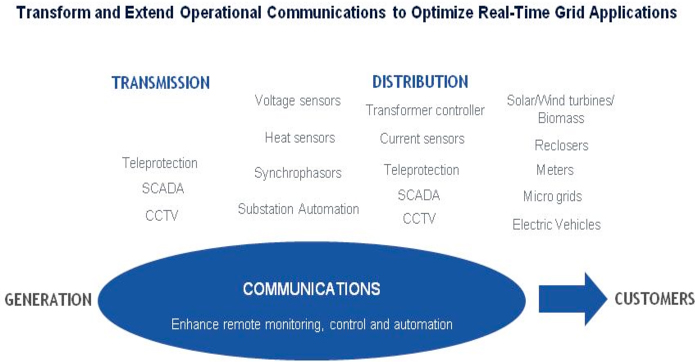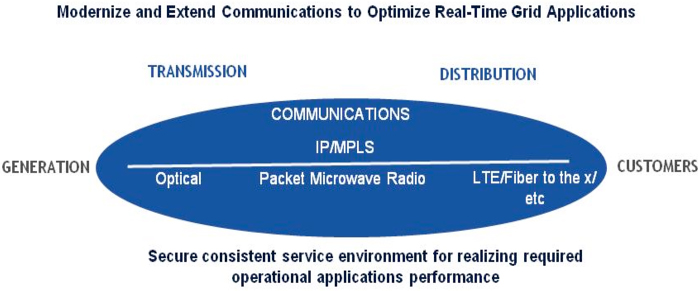Power utilities worldwide are exploring or actively engaged in efforts to make their grids smarter through projects such as substation automation, distribution automation and advanced metering infrastructure. For each power utility, the implementation of a smart grid means something different. Regardless of their overall approach, a smarter communications network needs to be part of their new energy delivery strategy.
Why is this so critical? A key enabler for the transformation of a utilities’ transmission and distribution grids is a modern, reliable, and flexible communications infrastructure that can securely route increasing amounts of monitoring, control and status information effectively, efficiently and on time. New smart grid applications provide utilities with better visibility to operate electric systems more efficiently and new options to automate functions. The increased movement of data, coupled with robust analysis capabilities can offer the benefits of enhanced safety, reduced operating costs, increased power quality and improved outage response. The communications network is at the heart of these functions.
It is not just utilities themselves that have an interest in the deployment of smarter grids and the communications networks that make them possible. Governments consider smart grid technologies as a means to improve power quality, reduce need for additional generation capacity and reduce carbon emissions. Business and residential customers can take advantage of new features such as time-of-day charging and the availability of renewable energy from independent power producers. Finally, regulators increasingly view smarter communications networks as a means to more efficient energy markets and continued safe and reliable energy delivery.
For transmission operators who have been maintaining communications infrastructures, the desire to introduce smart grid applications requires them to consider an evolution of their time division multiplexing (TDM) over Synchronous Digital Hierarchy (SDH) or Synchronous Optical Network (SONET)-centric communications networks. Internet protocol (IP) technology is the communication standard for which new smart gird devices and applications are being developed. It is well recognized that to efficiently support the growing amount of smart grid applications, utilities need to transition to IP-based networks.
Distribution operators, who may have minimal communications coverage in most of their medium voltage grids and often none in their low voltage grid, now face the challenge of extending and deploying new communications infrastructures for distribution automation plus supporting new intermittent micro-generation sources – solar, wind turbines, biomass that could unbalance the grid. A flexible transformation is required to preserve existing investments and to minimize risks. Again, IP-based networks are generally acknowledged to be the path forward.

Swissgrid Uses IP/MPLS and optical technologies to strengthen grid operations
Swiss electricity transmission system operator Swissgrid has turned to IP/ MPLS and WDM optical technologies for the management of its electrical grid. Swissgrid’s new ‘Grid Control Network’, which became operational early in 2016, provides monitoring and switching for the electricity transmission grid, resulting in better alignment of power supply and demand, enhanced security and an exceptional level of reliability.
For this project, Swissgrid implemented two IP/MPLS -based networks, one an operational network and the other a business communications network. Both IP/ MPLS networks are overlaid on an encrypted Dense Wavelength Division Multiplexing (DWDM) and Coarse Wavelength Division Multiplex (CWDM) network, to support high-speed, high-capacity data transmission.
The solution is supporting mission-critical operational services such as Supervisory Control and Data Acquisition (SCADA) systems, Teleprotection, video surveillance via closed-circuit TV (CCTV), site access control and intrusion detection. With these capabilities in place, Swissgrid expects to maintain the highest level of reliability, safety and security across the entire grid.
The ‘Grid Control Network’ is being operated by Swissgrid from two mission-critical Grid Control Centers (data centers), which are interconnected through encrypted, redundant DWDM wavelength services. The grid has a length of 6,700 km, and the ‘Grid Control Network’ links 140 substations as well as a number of power plants, data centers and offices.
In addition to supporting grid operations, the network also enables business communications between electricity substations and Swissgrid locations for tasks such as local area network (LAN) connectivity and voice over IP (VoIP) in a highly secure way.
An approach which has been gaining significant momentum with both transmission and distribution utilities is the implementation of Internet Protocol/Multi-protocol Label Switching (IP/MPLS) technology to support grid operations. IP alone cannot adequately support some mission critical operational communications due to its inability to provide the predictability and reliability required by applications such as teleprotection and synchrophasors.
IP/MPLS takes the non deterministic nature of IP and provides deterministic controls to achieve the required performance for mission critical operations traffic. It supports network resiliency, quality of service, security, and convergence, and provides a management platform to automate and simplify operations management. Reliable communications and end-to-end service consistency throughout the network is essential to meeting key smart grid application requirements, particularly the need to utilize information management technologies and maintain two-way communications.
An IP/ MPLS-based communications network incorporates state-of the-art technologies to enable a power utility to deploy a highly available IP network that can support both current and emerging applications far into the future, while continuing to supporting existing TDM and legacy applications. This new IP/MPLS network will allow the utility to maximize the cost effectiveness and efficiency of its network without jeopardizing reliability. It also enables the deployment of new devices and applications that can improve operational and workflow efficiency. A highly available IP/MPLS network is ideally suited to support mission-critical operations, while providing a platform to address all other business communications requirements – one network can do it all.
One of the key advantages of using IP/MPLS in the core and throughout the network is that it can easily interoperate with other networking infrastructure as needed, such as microwave packet radio or wavelength division multiplexing (WDM) optical transport technologies to effectively reach remote grid substations and devices while providing a consistent service environment. An optical transport backbone can also provide reliable high bandwidth protocol independent layer 1 connectivity to data centers and utility corporate offices. These data transport technologies are designed to address utilities’ stringent cyber-security requirements. For example WDM supports capabilities such as intrusion detection and low latency wavelength encryption for operational and business communications traffic on this network. This means that potential physical intrusions on the fiber cable can be detected and located. In case of an intrusion, sensitive data is protected through embedded optical layer encryption, which complements end-to-end encryption that is supported across the entire IP/MPLS network.
In the end, what utilities have is a comprehensive, high-capacity, highly secure and resilient communications network that can address all of their operational and business needs, both today and for the foreseeable future as they deploy their Internet of Things (IoT) strategy.
About the Author
David Christophe is Director of Utility Solutions Marketing at Nokia, where he focuses on helping distribution utilities modernize the communications networks that support their grid operations. David has a 20 plus year background in IP/packet networking, and has spent more than a decade working with utilities to enhance their mission-critical communications networks.









